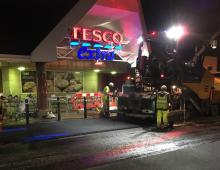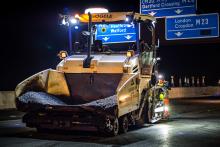
The work was carried out by Hanson's contracting team in partnership with designer Atkins on the A414 – between Park Street roundabout and the M1 junction 8 between St Albans and Hemel Hempstead – as part of the National Highways Area 6 & 8 framework agreement.
The project used Hanson's Tufflayer stress absorbing membrane interlayer (SAMI) to address the issue of reflective cracking caused by the underlying concrete road, plus a thin asphalt surface course that trialled several new low carbon solutions.
The asphalt on the westbound carriageway included Shell LT R, which was produced and laid at a lower temperature using Hanson's ERA warm mix process, which reduces energy consumption and associated carbon emissions by up to 15%.
LT R also includes additives derived from waste plastics, reusing the material and preventing it from going to landfill. Using ERA warm mix asphalt to produce the 940 tonnes of LT R used on the project generated a carbon saving of 2,246kg of CO2 – the equivalent of driving more than 51,000 miles, or twice around the world!
On the eastbound carriageway, Shell’s AgeSafe bitumen has been used. This incorporates an additive to prolong the life of the asphalt surfacing, reducing the need for intervention and further cutting carbon emissions. This was produced using our REA (reduced emissions asphalt) process, which helps to minimise the impact of asphalt production and laying on local air quality.
“Collaboration within the supply chain allows us to look at advancements in technology that can deliver lower carbon solutions and help our customers meet their decarbonisation targets,” said Adrian Hadley, head of technical (asphalt and aggregate).
“The A414 is a perfect example of this and the performance of the different combinations of materials will be closely monitored to see how they react compared with the control sections.
“As part of the project, we also used a shuttle buggy to provide a constant supply of asphalt to the paver, enhancing the smoothness of the road. Smoother surfaces without joints create less friction with tyres, reducing fuel consumption and ongoing CO2 emissions throughout the life of the road.”










